A food truck flown by helicopter across Alaska. A floating target in the Pacific Ocean promising free tacos if it’s struck by a falling satellite. An old restaurant lifted onto a trailer and towed 40 miles to a new home. A national campaign to liberate a closely guarded trademark.
In the annals of cheeky marketing strategies and publicity stunts, one brand reigns (Crunchwrap) supreme. Since its founding in 1962, Taco Bell has seemingly played by a different set of rules than most other restaurant companies, taking big swing after big swing not only with its marketing but also with its menu and its operations. Through multiple generations of leaders, the Mexican juggernaut has protected its spirit of irreverence and originality and packaged all of it as authentically Taco Bell.
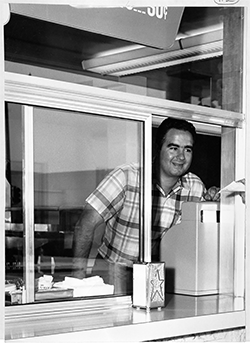 That spirit is rooted in founder Glen Bell, left, who, when he founded Taco Bell in Downey, Calif., was inherently writing a new blueprint for QSR success.
That spirit is rooted in founder Glen Bell, left, who, when he founded Taco Bell in Downey, Calif., was inherently writing a new blueprint for QSR success.
“He was tacos in a burger world. He was tacos in a pizza world. He decided to do something different,” said Sean Tresvant, Taco Bell’s chief global brand and strategy officer who takes over as CEO in January. “Sixty-one years ago, Mexican food was very nascent. … Now, fast-forward 61 years, we're trying to continue that DNA, continue that legacy in everything we do.”
Trying and succeeding. Taco Bell’s legacy of disruption has firmly solidified its place among the global zeitgeist, its offbeat attitude generating countless headlines and memes — and, more importantly, traffic at its restaurants. Today, Taco Bell is the fourth-largest restaurant brand in the U.S., with roughly $13 billion in sales in 2022 at north of 7,000 locations, according to NRN’s most recent Top 500 report.
But it’s hardly reached its limit. With plenty of runway ahead of it, the subsidiary of Yum! Brands isn’t simply resting on its laurels as a legacy chain; rather, it’s aggressively innovating its way into the future.
How to be restlessly creative
To understand what makes Taco Bell such an iconic brand, start with one of the unfair advantages it enjoys in the marketplace, one that it has cultivated over the past 61 years: emotional resonance with consumers. Call it a cult, a vibe, or whatever you like, but Taco Bell enjoys a special relationship with its biggest fans that transcends the menu and restaurants.
With that relationship, much of Taco Bell’s success is in how it listens and responds to loyalists, whether that’s by returning favorite menu items (hello, Mexican Pizza) or rescuing old locations — like when it answered fans’ calls on social media to save the brand’s original location by towing it from Downey to Taco Bell headquarters in Irvine, Calif.
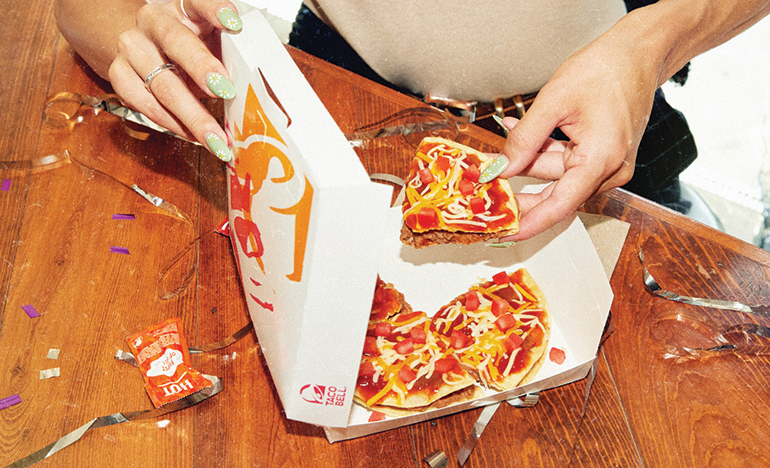
When Taco Bell reintroduced its Mexican Pizza in May 2022, it quickly sold out, largely thanks to promotion from the hip-hop artist Doja Cat.
“Our consumers own the brand; we’re just shepherds of the brand. And when you really listen to what they say, they want the iconic things to come back [and] they want us to save our heritage,” said Rob Poetsch, head of communications for Taco Bell. “Those are the types of things that you can't make up, right? It is such an iconic brand that has an emotional connection to people. You have to lean into that.”
To be those good shepherds, Taco Bell exercises a mindset that executives frequently refer to in conversation: being “restlessly creative.” The idea, Poetsch said, is that everyone in the company — from executives to franchisees to frontline employees — is expected to be creative at their craft, to “look at something that might be relatively simple and ask yourself, how can we be better at this?” he said. “How can we make this easier for the consumer? How can we make it easier for our franchisees, for our operators? It's really asking those questions constantly and evaluating everything that you do through that lens.”
This restless creativity manifests itself throughout the organization, but never more clearly than in Taco Bell’s marketing. Going back decades, Taco Bell has demonstrated its ability to creatively connect with consumers with an irreverent attitude and a penchant for campaigns that tap into the mainstream mood and consciousness.
The company’s history is rife with examples. There was the food truck flown to a remote corner of Alaska to promote Doritos Locos Tacos, and the target in the Pacific that capitalized on the Mir space station’s much-publicized fall to earth in 2001. But there have been other memorable campaigns that were cultural touchpoints: its support of the “Batman” movie in 1989, one of the first such industry promos tied to a major blockbuster; its sponsorship of ESPN’s inaugural X Games in 1995; its talking chihuahua whose famous tagline (“Yo quiero Taco Bell”) would have certainly blown up TikTok if it had arrived 20 years later.
More recently, there was the Mexican Pizza saga. The menu item was victim of COVID-era streamlining in 2020, but hip-hop star Doja Cat tweeted at Taco Bell to bring it back. Not only did Taco Bell eventually do exactly that, but it invited Doja Cat into the fold to help promote it, which she did in a Super Bowl ad, on her TikTok, and even on stage when she performed at the Coachella music festival. The Mexican Pizza sold out in less than two weeks after it rejoined the menu.
“It wasn't us asking her to do that. We didn't pay her to do that,” Tresvant said of Doja Cat’s initial social media support. “She authentically — because she's a fan of the brand — warmly recommended for us to put it back on the menu. We had some fun with it. It all led to the relaunch of the Mexican Pizza, which is now permanent on the menu.”
Then there’s this year’s Taco Tuesday effort, in which Taco Bell petitioned competitor Taco John’s to relinquish its hold on the Taco Tuesday trademark, which it held in every state but New Jersey (where an independent restaurant, Gregory’s Restaurant & Bar, held the trademark). To rally support for the cause, Taco Bell enlisted Los Angeles Lakers superstar LeBron James — who’d been vocal about his love of Taco Tuesday in the past — to promote the campaign on his social media and in a TV spot.
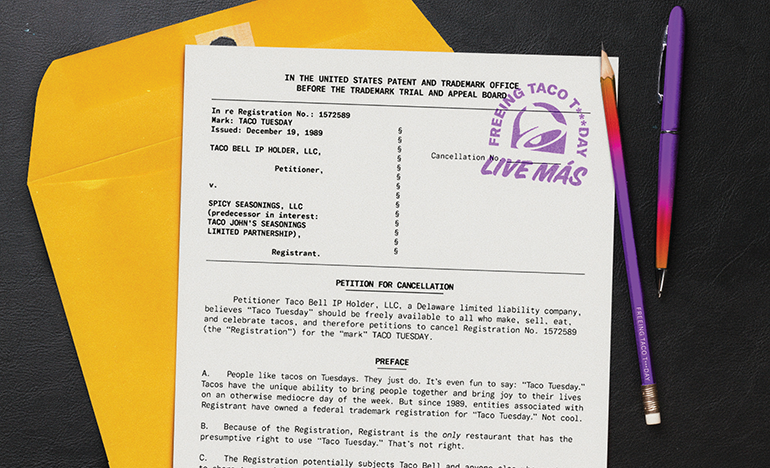
Taco Bell “liberated” the Taco Tuesday trademark.
“He's a cultural icon and arguably one of the best basketball players of all time, so it wasn't just about ‘let's go get a celebrity off the shelf to liberate Taco Tuesday,’” Tresvant said. “[It was] let's get somebody authentic to the cause, such as LeBron James, who celebrates Taco Tuesday with his family.”
Taco John’s gave up the trademark in July; Gregory’s followed suit in October. Taco Bell celebrated by picking up a $5 million taco tab on DoorDash for customers ordering from over 20,000 Mexican restaurants across the country. (It and Taco John’s also pledged funds to charity as a make-nice at the end of the “feud.”)
This all fits perfectly into Tresvant’s objectives for the brand. The former chief marketing officer of Nike’s Jordan Brand, hired for his current role in December 2021 and christened the next chief executive when current CEO Mark King announced he would retire in June, began his tenure at Taco Bell by confirming who the brand’s core customer was: the “cultural rebel,” as he calls it. From there, he rolled out his four marketing philosophies that would reach that customer: fewer, deeper, bolder (“you can do a lot but I think you break through when you focus on big things”); be nimble (“how do we make sure we're nimble and we're moving at the pace of the consumer”); math and magic (“how do you have the gut with the magic, but you also have some math in the data?”); and hitting people in the head (“you’ve got to be functional, you’ve got to make sure that you are doing the right things”) and in the heart (“you’ve got to get them emotional about your brand”).
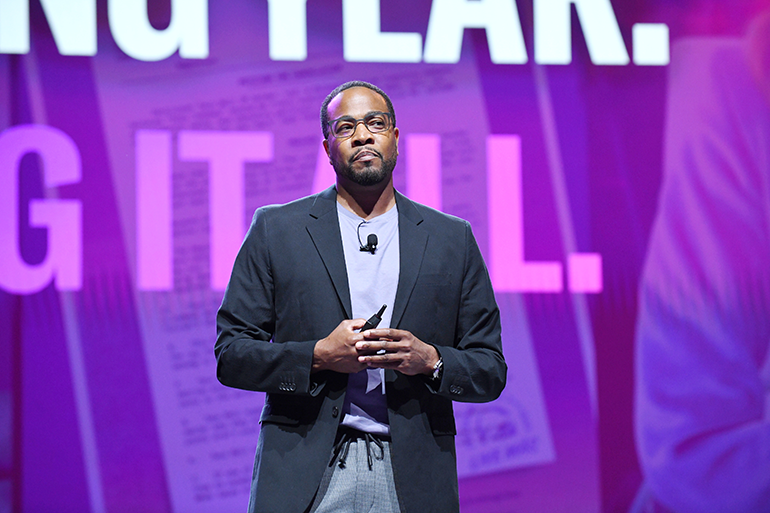
Sean Tresvant was hired for his current role in December 2021 and christened the next chief executive when current CEO Mark King announced he would retire in June.
Easier said than done, of course. In order to preserve Taco Bell’s unicorn status as a beloved chain that has been adopted into the lifestyles of generation after generation, the company must be willing take some risks.
“It’s about taking big swings to grow, and for us to be uncomfortable, because I think if you're going to have a big idea, of course it you would be a little uncomfortable,” Tresvant said. “And we embrace that as a culture.”
Taking big swings
Security at Taco Bell’s Irvine headquarters is so tight you might think the building was hiding nuclear codes. One needs to swipe a badge to get in the front door and then again to get through the door past the lobby. Riding the elevator requires another swipe. By the time one swipes for entry into the most vaunted space in the entire building — the Innovation Kitchen — they’ve practically got deeper clearance than the Secret Service at the White House.
In the Innovation Kitchen, Taco Bell has reason to be protective. If marketing is the soft shell of Taco Bell’s Double Decker taco of a traffic-generation strategy, then its menu R&D is the hard shell. That emotional connection the chain enjoys with its customers starts with its menu, which has come a long way since the days when founder Bell had to teach customers that “taco” was not pronounced “tay-co.”
There are the signature classics that have found their way to the menu in the last few decades: the Chalupa, the Cheesy Gordita Crunch, the Crunchwrap Supreme. But increasingly, Taco Bell’s menu launches have been less strategic promotions than seismic events. The Doritos Locos Tacos — tacos leveraging Doritos chips as the shell — were a cultural phenomenon after they launched in 2012, becoming the company’s biggest menu launch by selling more than a billion tacos in their first year. That title didn’t last long, though, as Nacho Fries came along in 2018 to unseat the DLT.
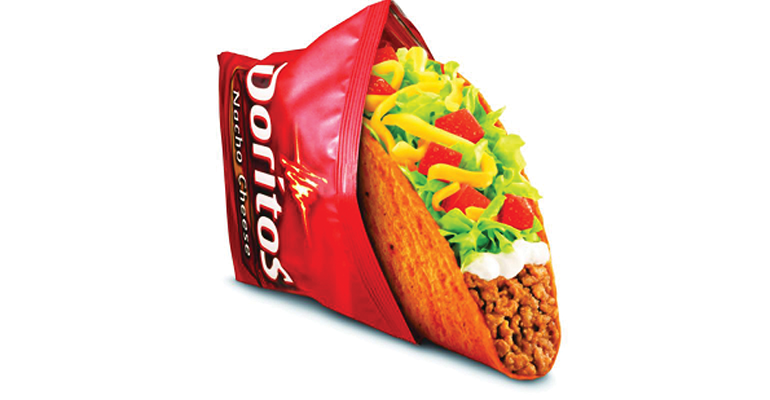
The Doritos Locos Tacos — tacos leveraging Doritos chips as the shell — were a cultural phenomenon after they launched in 2012.
Liz Matthews, Taco Bell’s chief food innovation officer, said the path to a successful Taco Bell menu launch is “quite messy and glorious” — one part formal process, one part team members “talking, collaborating, eating together, talking to consumers and kind of building on those ideas.” She said Taco Bell tests about 20-30 new dishes per year, with something like five to 10 of them rolling out to menus in a limited-time capacity. Getting to that point starts with hundreds of ideas that the R&D team funnels down to select finalists, using a variety of filters that determine whether the dish is a fit for the menu.
But Matthews emphasizes that those filters come later in the process, not at the beginning.
“You have to preserve big ideas. If I thought about every single thing that I've got to do to this dish before I get it to market, I would just go home. Because it's a lot, right? I've got operations. I've got supply chain. I've got a million different things that I need to consider on the journey,” Matthews said. “But in that moment, it needs to be about the idea and building it and making it beautiful and then putting it in front of the consumer. And if they tell me, like, ‘Holy smokes. I'm so down with this, I love it,’ that's when we're like, ‘OK, we’ve got something, and now we'll figure it out.’ But the world is filled with challenges, right? So if we worry about them too early, you tend to kill things. And you can't kill ideas.”
The big ideas-turned-limited time offers of 2023 demonstrate the staggering breadth of Taco Bell’s innovation, with everything from Crispy Chicken Nuggets to Baja Blast Gelato, Breakfast Tacos to Mtn Dew Energy Baja Blast, Watermelon Berry Freeze to a Vegan Crunchwrap.
Recently, two additional filters Taco Bell has applied to its R&D process are nutrition and sustainability. Whereas the R&D team has long rallied around the concept of being on a “food-for-all journey,” these days it’s really “food and planet for all,” said Missy Schaaphok, Taco Bell’s director of global nutrition and sustainability.
With sustainability, Taco Bell is a major part of parent Yum’s goal of cutting greenhouse gas emissions by 50% by 2030. Earlier this year, it announced a collaboration with supplier Cargill and the National Fish and Wildlife Foundation to implement regenerative agriculture practices across cattle grazing lands by distributing $4 million in grants to farmers. That initiative followed a partnership with waste management company TerraCycle, through which customers can recycle their condiment packets (Taco Bell’s or competitors’) by either dropping them into designated bins at Taco Bell or mailing them in to TerraCycle, which cleans, melts, and remolds the packets into hard plastic. The program could help divert more than 8 billion sauce packets distributed at Taco Bell annually.
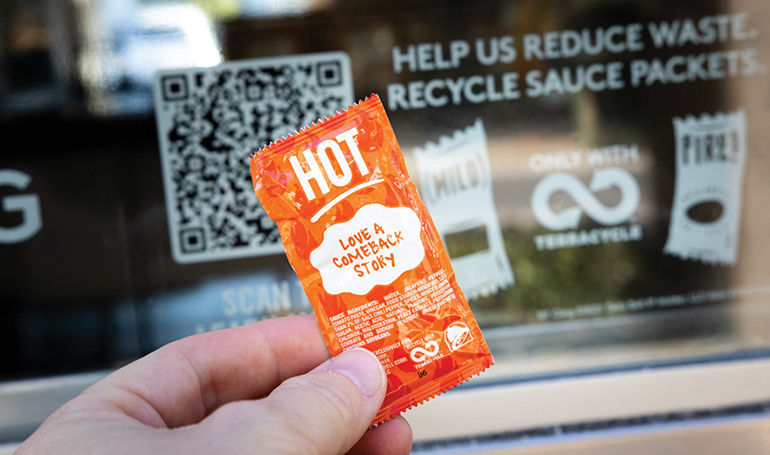
Taco Bell partnered with recycling company TerraCycle to clean, melt, and remold used condiment packets.
The sustainability message runs parallel to Taco Bell’s nutrition commitment, which likewise gives discerning customers the power to choose an experience with the restaurants that aligns with their lifestyles.
“Our menu is about choice, so if someone wants something indulgent, we have that. If they want something that's better for them, we have that. And if they want something vegetarian, we have that,” Schaaphok said.
Taco Bell has developed a sterling reputation with the vegetarian community in particular for the scope of its meat-free options. The brand has more than 30 vegan or vegetarian ingredients, offering more than 1 million vegan or vegetarian combinations. A full 23% of Taco Bell’s menu mix is made vegetarian, according to Schaaphok.
The R&D team continues to develop new items that would appeal to meat lovers and vegetarians alike. Along with the recent test of the Vegan Crunchwrap, Taco Bell this fall began testing a Vegan Nacho Sauce that re-created its famous nacho cheese for the non-dairy crowd. When considering the scale of Taco Bell, the potential impact for a product like that is astounding.
“If you can make a product that everybody loves, it’s 45 million people a week that are eating that product. If you can reduce sodium without even people noticing it, or offer vegetarian, you're affecting so many people,” Matthews said. “Where else can you do something like that where — I know it sounds hokie — but it's like, we can actually make a difference. And that's pretty cool.”
Better, faster, stronger
Of course, good food and good message alone cannot single-handedly make the kind of impact that Taco Bell has for decades. The brand also frequently adapts its operational model to be in line with customers’ wants and needs.
Two recent store innovations are perfect examples of how Taco Bell leverages operational creativity to align with consumer habits: the brand’s Defy drive-thru prototype and its Go Mobile store design. The former is a futuristic drive-thru-only model that streamlines off-premises business with a two-story frame atop four lanes. Along with one standard order-and-pay window, Defy boasts three lanes committed to mobile orders and delivery pick-ups, with customers scanning a QR code upon arrival and receiving their food in less than 2 minutes via a lift that drops down from the kitchen above.
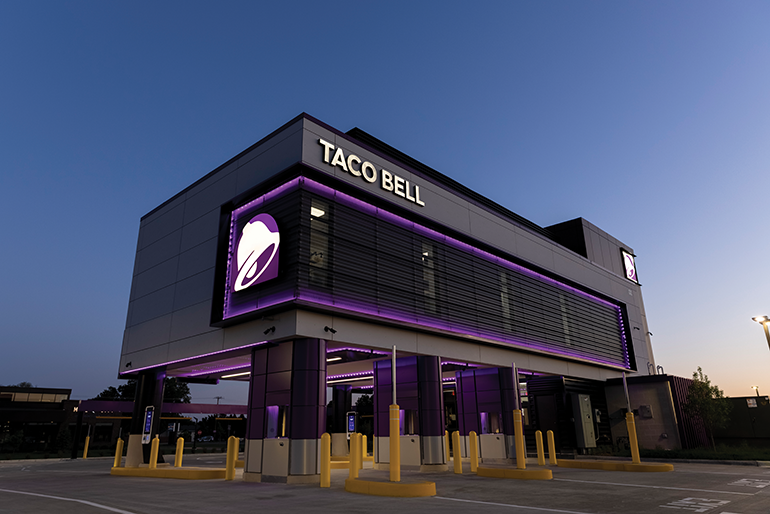
The Taco Bell Defy prototype is a perfect examples of how Taco Bell leverages operational creativity to align with consumer habits.
While Defy has just one open location to date, in a Minneapolis suburb, the Go Mobile prototype already has a 2.0 version in the marketplace and fast growth underway. The new model is a small-footprint design intended for real estate the company couldn’t previously occupy and focuses on drive-thru service — one lane or two — along with parking spots committed to digital and third-party orders, grab-and-go shelves, and a walk-up window. In the kitchen, the Go Mobile has a kitchen display system that lets employees prioritize orders based on size and complexity, access build cards, and share orders with other employees.
These new models are designed to enhance throughput and efficiency and, in the case of Go Mobile, increase store profitability with a significantly lower capital expenditure and a focus on digital transactions. Not only has parent Yum stated its intention to achieve 100% digital sales in the future (as of its second-quarter earnings it was at 45%), but also current Taco Bell CEO Mark King has said the chain aspires to cross 10,000 units “in the coming years.” And Scott Mezvinsky, Taco Bell’s president of North America, said the key to the company’s growth is improving unit economics so that franchisees are motivated to invest in expansion.
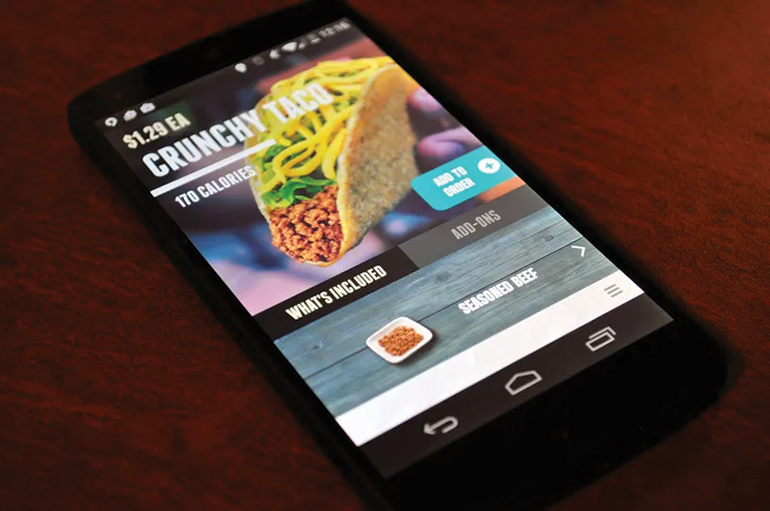
Taco Bell parent Yum Brands intends to achieve 100% digital sales in the future.
“I think if we start with the consumer and we give the consumer a great experience and great products and a great … restaurant for them to see, that [will] ultimately lead to top-line sales, which ultimately leads to bottom-line [profit],” Mezvinsky said. “And as we continue to grow the overall brand and stay relevant and distinctive, then I think the unit economics … alone will drive growth.”
This focus on newer, more efficient restaurant designs began with former CEO John Martin, who joined Taco Bell as president in 1983 and led the chain for 13 years. Martin’s tenure not only saw Taco Bell innovate on the value front — he spearheaded the 59¢-79¢-99¢ menu — but he also pushed Taco Bell toward a smaller, more efficient store design.
“He envisioned the restaurants to be much more of a point of access,” Poetsch said. “This was obviously before the digital age — this was in the ’90s — and what he did was something really brilliant: He figured out a way to make the restaurants smaller and the kitchens simpler. And what that did is it created a more consistent and faster experience for the guests.”
That visionary kind of thinking continues to motivate leaders at the Irvine headquarters. Mezvinsky said Taco Bell maintains a spirit of innovation by constantly testing, learning, and testing again.
“Even innovation that may not work out in the long run, I think we still learn from that,” he said. “You know, we took a swing at something. Maybe it didn't quite work, but what did we learn? And how do we apply that going forward? If you never push yourselves, and if you never fail, then you’re actually not learning as much as you should.”
Of course, with consumers’ behavior constantly fracturing across myriad distribution points and their attention across countless media platforms, innovation could seem overwhelming. How can a brand as universally appealing as Taco Bell present itself on every channel without stretching itself too thin?
Tresvant said Taco Bell focuses its approach with three goals: It aims to be in customers’ palms, in their pursuit, and in their path. The brand’s marketing function helps to satisfy the palm and pursuit elements — creating great content that captures their attention on their phones (“palm”) and develops a relationship in which they want to experience the brand as much as they want to buy their product (“pursuit”) — but being in their path is a critical function of the company’s operations team and franchisees.
“We’ve got to create great restaurants at the end of the day,” he said. “Whether an aggregator is delivering your food [or] whether you're going into Taco Bell, we’ve got to build great assets that are in their path and in the right places with the right franchisees.”
A Boomer in a Gen Z world
It’s remarkable to consider the rapid pace of innovation that Taco Bell has maintained, particularly when remembering it opened its first restaurant when John F. Kennedy was president. The 61-year-old company has thrived generation after generation in an industry that is constantly evolving at the whims of consumers who are only just discovering the power of discretionary income.
Indeed, Taco Bell is a Boomer in a Gen Z world, yet somehow its innovation never feels inauthentic. Part of that is because, as Poetsch said, Taco Bell is a “youthful brand” and “has a lot of permission to take risks.” But a big part of it is also intentional; the company has designed a culture that inspires the “restlessly creative” nature from the CEO down to frontline employees.
“I think leadership is the thing that separates good to great, great to extraordinary, and I want to make sure that we’re building a culture of leadership and leaders within Taco Bell,” Tresvant said.
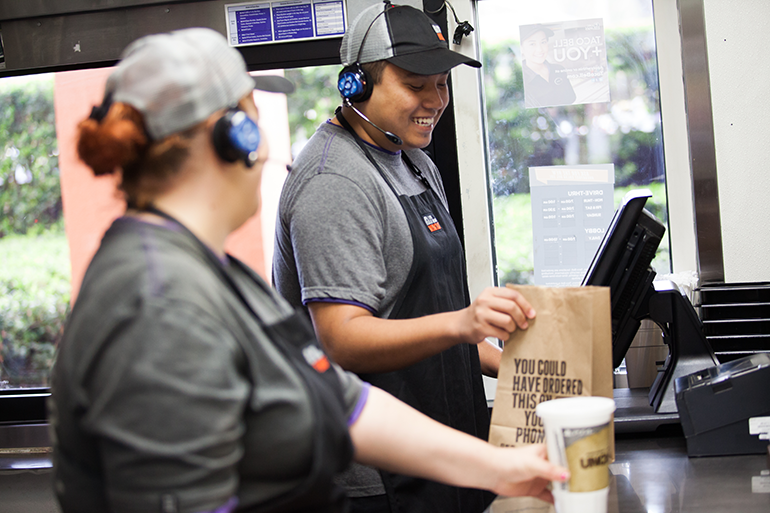
Taco Bell’s spirit of “restless creativity” extends from the C-suite down to frontline employees.
Keeping that culture fresh and humming is Kelly McCulloch’s job. McCulloch is the global chief people and transformation officer for Taco Bell, and she’s responsible for ensuring that everyone in the company has bought into its “journey” and rejected the status quo.
The goal, she said, is constant evolution.
“We have some pretty strong competitors out there,” McCulloch said. “And so how do we not get complacent? How do we make sure that we’re running our own playbook? How do we make sure that we’re continuing to put our best foot forward? How do we constantly challenge the ways that we’re working and push ourselves to get better and better?”
McCulloch points to a number of examples big and small that attempt to accomplish that. At a smaller scale, it’s the franchisee who paid $15,000 toward a car for a veteran employee — $1,000 for every year they’d been with the restaurant — as a means to taking care of and motivating the local team. At a bigger scale, it’s the company-wide Menu Blast challenge that encourages employees to hack the menu and discover new innovations, or the Internal Incubator that was launched in the post-pandemic, remote-work environment and “operationalize[s] creativity, weaving it into our corporate culture to empower every employee at every level to channel their passion into ideation,” as King wrote in a blog post when it was launched.
“The premise of that is that great ideas come from everywhere, not just the cool kids in marketing, but everybody across the organization, whether that’s here in the building or out in the restaurants — especially in the restaurants, right?” McCulloch said. “That’s where problems get solved all the time.”
Employees who opt into the Internal Incubator, she said, are given training in how to “brainstorm at the next level” and “get to really juicy, exciting, interesting solutions.” There’s a Shark Tank–style process to vote on the best ideas, which are then tested within the company.
The trick now, McColloch said, is scaling this culture to even loftier heights. Taco Bell has ambitious plans for global expansion and a surprising amount of runway to grow all over the world.
Nilesh Patel, chief growth officer for Taco Bell, said 2022 was the first year that the brand opened more restaurants abroad than in the U.S. Internationally, today, Taco Bell has more than 1,000 units in 30-plus countries, with significant presences in nations like China, India, the United Kingdom, and Spain.
And yet, “there are over 100 countries out there that have KFCs but that don’t have a Taco Bell,” Patel said, noting the notoriously strong international business that Taco Bell’s Yum sister brand boasts. “If you just paint that picture of how much potential we have, it’s massive.”
Patel said Taco Bell isn’t planning to just replicate its U.S. model in global markets. Rather, his job is to “make sure that our brand is relevant and distinctive and appropriately positioned for that market” when it enters a new country. That may still include operational innovations that have taken root stateside — consumers the world over are increasingly leveraging digital platforms to facilitate their transaction — but with variations on the Taco Bell menu. They start with the core products of tacos, burritos, quesadillas, and nachos, then riff on those base products using local flavors.
The unfair advantage that Taco Bell enjoys all over the world, he added, is loyalty from the consumer who is willing to take a chance on whatever the brand throws at them.
“The cultural rebel is everywhere, and what we know is that the cultural rebel is the one that’s really pushing the boundaries, the one that really wants to think differently. And that’s where our brand fits so well,” Patel said. “So we’re making sure that we’re giving them a chance to experience Taco Bell and bringing that to life in their local markets.”
It’s an ongoing challenge, one that Taco Bell leaders seem eager to tackle day in and day out by living at the intersection of legacy and innovation.
“There’s so much here that is so good … and there’s a need to evolve for the future,” McColloch said. “So how do you honor the past? How do you make sure that you’re keeping those pieces that make us inherently Taco Bell, and how do you figure out the pieces of the future that I want to pull forward into the organization that will continue to help us stay true to who we are but help us win even more? It’s an art, for sure.”
Contact Sam Oches at [email protected]




